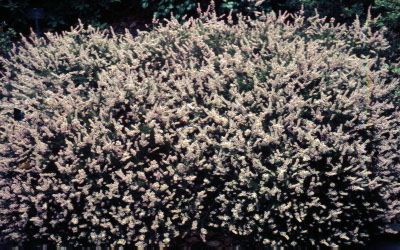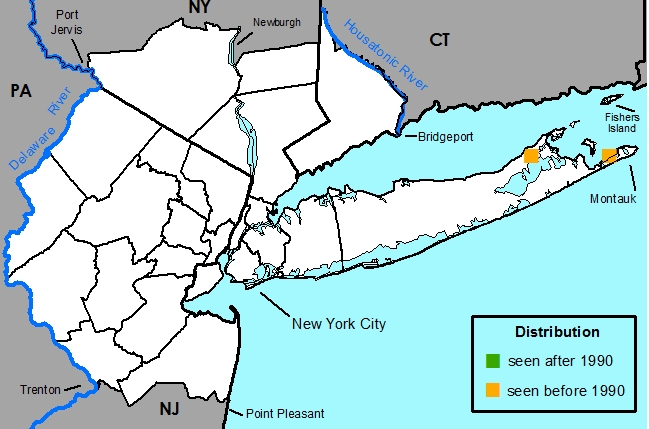Calluna vulgaris (L.) Hull - Heather

Heather
Photo © Peter Nelson.
Common Names
HeatherField Identification
Small shrubs with opposite decussate needle-like leaves and white flowers.Food uses
Disclaimer: The information provided here is for reference and historical use. We do not recommend nor do we condone the use of this species for food purposes without first consulting a physician.Used to flavor ale.
Other uses
Used for bedding, thatch, brooms, fuel, baskets, rope, and an orange dye.
Common names
Bazzom
Bissom -- used as besoms, or brooms.
Black Ling
Broom
Dog Heather
Griglans -- from Cornish "grhglon," heather bush.
Griglum
Hadder
Heath
Heather
Hedder
He-Heather
Mountain Mist
Red Ling
Scotch-Heather
Stories
Scottish Highlanders took heather beds with them when they settled in North America. In this way Scotch-Heather was introduced into North America.
Nomenclature
*Erica vulgaris L., Sp. Pl. 1: 352. 1753. *Calluna vulgaris (L.) Hull, Brit. Fl., ed. 2, 1: 114. 1808. *Calluna erica Lamarck & DeCandolle, Fl. Franç., ed. 3, 3: 680. 1815, nom. illeg. (Art. 52.1). TYPE: Finland? Lapland: 1762, Linnaeus s.n. (Lectotype: Flora Lapponica sheet 141, P), selected by (Jarvis & McClintock, 1990).*Calluna atlantica Seem., J. Bot. 4: 306, t. 53. 1866. TYPE: Cultivated at Kew, Anonymous s.n. (Holotype: BM?)
Description
[Based on Atlantic Co., NJ, and N Stonington, Conn., specimens; both outside our range.]HABIT perennial, evergreen, chamaephyte, shrubs, autotrophic, monoclinous, with adventitious roots, 1-3 m tall, not modified or with rhizomes.
STEMS ascending or erect or decumbent, round, not winged, "regular". Prickles absent. Bark ridged, not exfoliating, dark orange-red. Branches erect or ascending, orange, round, not winged, 1-1.5 mm in diam. Twigs orange or reddish orange, not odoriferous, angled, 3-7 mm in diam., smooth, hairs short and unbranched, erect, unicellular, uniseriate, white, moderately dense, throughout, not glabrescent, without glands. Pith present, light yellow, round, continuous. Thorns absent. Aerial roots absent. Sap translucent. Resin absent.
LEAVES decussate, 2 per node, spaced evenly along stem, appressed to stem, simple. Stipules absent. Leaves sessile. Leaf: abaxial surface green, adaxial surface green, blades narrowly elliptic or lanceolate, supervolute-involute, symmetric, 0.15-0.25 cm long, 0.04-0.09 cm wide, coriaceous, base auriculate, margin entire or ciliate, apex acute or obtuse, abaxial surface glabrous or hairs short and unbranched, erect, unicellular or multicellular, uniseriate, white, sparse, throughout, glabrescent, without glands, adaxial surface glabrous, dull, without glands. Hyphodromous venation, veins 1. Leaf lobes absent. Spines absent. Tendrils absent.
INFLORESCENCES monomorphic, regular or, if dimorphic, female inflorescence simple or compound, single flower and spike (spike-like axillary masses), terminal or axillary. Peduncle present, 0.1-0.15 cm long. Rachis absent, with bracts. Bracts sessile, blades: abaxial surface green, adaxial surface green, narrowly elliptic or lanceolate, supervolute-involute, 1.5-2.5 mm long, 0.4-0.9 mm wide, base sagittate, margin entire or ciliate, apex obtuse, abaxial surface glabrous or hairs short and unbranched, abaxial hairs erect, unicellular, uniseriate, white, sparse, throughout, not glabrescent, without glands, adaxial surface glabrous, without glands. Pedicel 0.8-1 mm long, glabrous or hairs short and unbranched, hairs erect, unicellular, white, moderately dense, throughout, not glabrescent, without glands. Bracteoles 4-6, sessile, at base of pedicel, not connate, bracteoles: abaxial surface green, bracteole: adaxial surface green, linear obtriangular, supervolute-involute, 0.8-1 mm long, 0.3-1 mm wide, base auriculate, margin entire or ciliate, apex acute. Cupules absent.
FLOWERS serotinous, formed on short shoots, monomorphic, with sepals and petals readily distinguishable from one another, bisexual, flowers light red or white, 4-merous, 2.7-3.8 mm long, 2.5-3.1 mm wide, 1-13 flowers per inflorescence, perianth of two whorls. Calyx present (petal-like), actinomorphic, crateriform, of free sepals, persistent, abaxial and adaxial surfaces the same color, light red or white, variable depending on cultivar, 2.5-3(-3.5) mm long, (1-)1.2-1.5(-1.7) mm wide. Sepals or sepal lobes 4, widely oblong or widely ovate, 2.5-3(-3.5) mm long, (1-)1.2-1.5(-1.7) mm wide, base cuneate, margin entire, apex obtuse, abaxial surface glabrous, without glands, adaxial surface glabrous, without glands. Epicalyx absent. Corolla present, actinomorphic, campanulate, of free petals, persistent, abaxial and adaxial surfaces the same color, light red or white, uniform, 2-2.7 mm long, 1.4-2 mm wide. Petals or petal lobes 4, obovate, abaxial surface glabrous, without glands, adaxial surface glabrous, without glands. Gynoecium syncarpous. Carpels 4. Stigmas 1, capitate. Styles persistent, 1, 2-2.3 mm long. Ovary superior, 0.5-0.6 mm long, 0.8-0.9 mm wide, nectiferous disk present. Locules 4. Placentation apical axile. Androecium obdiplostemonous. Stamens 8, 1.9-2.1 mm long. Anthers linear, opening along the long axis, opening 3/4 of entire anther to opening entire length of anther, bithecal, dark violet-red, glabrous, spurred. Filaments free, straight, red, glabrous. Staminodes absent.
FRUITS septifragal capsule, yellowish orange, globose, 0.9-1 mm long, 0.9-1 mm wide, hairs short and unbranched, erect, unicellular, uniseriate, white, dense, throughout, not glabrescent, without glands.
SEEDS 1 to 4, reddish orange, oblong, 0.6-0.7 mm long, 0.3-0.5 mm wide, wingless, not tailed, reticulate-foveate or reticulate.
Habitat
(Gimingham, 1972)Moist depressions in sand dunes. In general, Calluna vulgaris requires humid environments and rather high light. Soils are low in nutrients, moist, with pH 3.5-6.7
Species Biology
FloweringAug [week 1].
Pollination
"In Danish nature perhaps there is no plant the flowers of which may be pollinated in so many different ways as those of Calluna. Nearly all the commonest ways of pollination may be found realized in nature" (Hagerup, 1950).(Beijerinck, 1940) (Gimingham, 1960) (Hagerup, 1950) (Hagerup, 1954) (Haslerud, 1974)
Autogamy -- Some reports suggest that self-pollination is possible; others say this is of no importance.
Anemophily
Melittophily -- Bombus lucorum (L.) appears to be the most common and important; others include Sphecidae and Apidae.
Other -- Diptera and Thysanoptera "Hagerup describes the life history of a certain species of thrips, the greater part of which is spent in the flowers of Calluna, eggs being laid in the tissue at the base of the corolla. The insects feed on the nectar and soft parts of the base of the flower, carrying out pollination in the course of their movements within and between flowers" (Gimingham, 1960).
Fruiting
Unknown [in Europe seeds are shed from late September through November].
Dispersal
(Beijerinck, 1940) (Gimingham, 1972) (Legg et al., 1992)Anemochory -- "The wind is the chief agent in spreading Calluna seeds" (Beijerinck, 1940).
Endozoochory -- Capsules are also eaten by wood grouse, black grouse, elk, and deer, which then spread the seeds.
Germination
(Beijerinck, 1940) (Gimingham, 1960) (Gimingham, 1972) (Legg et al., 1992) (Young & Young, 1992)Light required -- Seeds require no stratification but do require light. They should be seeded on milled peat, not covered, and placed under mist or in a high-humidity environment. Germination takes 3-5 weeks, but under favorable conditions germination may be detected between 8 and 14 days after sowing, and up to 96% germination may be obtained in about 2 months. When temperatures are kept constant, the optimum germination lies about 20o C.